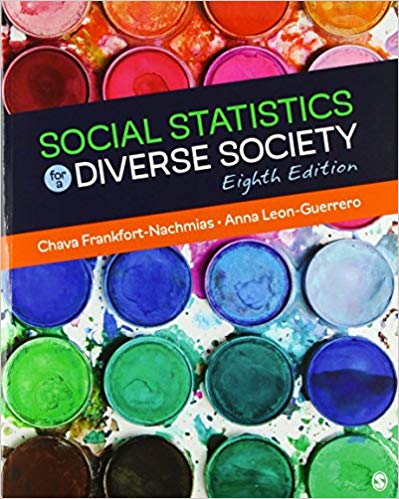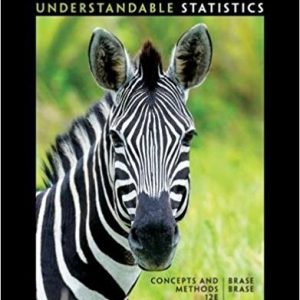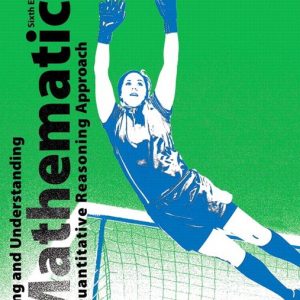Instant download Solution Manual for Social Statistics for a Diverse Society Eighth Edition pdf docx epub after payment.

Product details:
- ISBN-10 : 1506390757
- ISBN-13 : 978-1506390758
- Author: Chava Frankfort-Nachmias; Anna Leon-Guerrero
This new edition of Social Statistics for a Diverse Society continues to emphasize intuition and common sense, while demonstrating the link between the practice of statistics and important social issues.
Recognizing that today′s students live in a world characterized by a growing diversity and richness of social differences, authors Chava Frankfort-Nachmias and Anna Leon-Guerrero help students to learn key sociological concepts through real research examples related to the dynamic interplay of race, class, gender and other social variables. In addition, guides for reading and interpreting the research literature help students understand key concepts, while SPSS demonstrations and a rich variety of exercises help them hone their problem-solving skills.
Table of contents:
Preface
Acknowledgments
About the Authors
CHAPTER 1 • The What and the Why of Statistics
The Research Process
Asking Research Questions
The Role of Theory
Formulating the Hypotheses
Collecting Data
Analyzing Data and Evaluating the Hypotheses
Examining a Diverse Society
Learning Statistics
CHAPTER 2 • The Organization and Graphic Presentation of Data
Frequency Distributions
Proportions and Percentages
Percentage Distributions
The Construction of Frequency Distributions
Cumulative Distributions
Rates
Reading the Research Literature: Access to Public Benefits
Graphic Presentation of Data
The Pie Chart
The Bar Graph
The Histogram
The Statistical Map
The Line Graph
The Time-Series Chart
Statistics in Practice: Foreign-Born Population 65 Years and Over
CHAPTER 3 • Measures of Central Tendency
The Mode
The Median
The Mean
Reading the Research Literature: The Case of Reporting Income
Statistics in Practice: The Shape of the Distribution
Considerations for Choosing a Measure of Central Tendency
CHAPTER 4 • Measures of Variability
The Importance of Measuring Variability
The Index of Qualitative Variation
Statistics in Practice: Diversity in U.S. Society
The Range
The Interquartile Range
The Box Plot
The Variance and the Standard Deviation
Considerations for Choosing a Measure of Variation
Reading the Research Literature: Community College Mentoring
CHAPTER 5 • The Normal Distribution
Properties of the Normal Distribution
An Application of the Normal Curve
The Standard Normal Distribution
The Standard Normal Table
Reading the Research Literature: Child Health and Academic Achievement
CHAPTER 6 • Sampling and Sampling Distributions
Aims of Sampling
Basic Probability Principles
Probability Sampling
The Concept of the Sampling Distribution
The Sampling Distribution of the Mean
The Central Limit Theorem
Statistics in Practice: The 2016 U.S. Presidential Election
CHAPTER 7 • Estimation
Point and Interval Estimation
Confidence Intervals for Means
Statistics in Practice: Hispanic Migration and Earnings
Confidence Intervals for Proportions
Reading the Research Literature: Women Victims of Intimate Violence
CHAPTER 8 • Testing Hypotheses
Assumptions of Statistical Hypothesis Testing
Stating the Research and Null Hypotheses
Probability Values and Alpha
The Five Steps in Hypothesis Testing: A Summary
Errors in Hypothesis Testing
Hypothesis Testing With One Sample and Population Variance Unknown
Hypothesis Testing With Two Sample Means
The Sampling Distribution of the Difference Between Means
The Five Steps in Hypothesis Testing About Difference Between Means: A Summary
Statistics in Practice: Vape Use Among Teens
Hypothesis Testing With Two Sample Proportions
Reading the Research Literature: Reporting the Results of Hypothesis Testing
CHAPTER 9 • Bivariate Tables
How to Construct a Bivariate Table
How to Compute Percentages in a Bivariate Table
Reading the Research Literature: Racial Disparities and Educational Attainment
The Properties of a Bivariate Relationship
Elaboration
Reading the Research Literature: The Digital Divide
CHAPTER 10 • The Chi-Square Test and Measures of Association
The Concept of Chi-Square as a Statistical Test
The Concept of Statistical Independence
The Structure of Hypothesis Testing With Chi-Square
Statistics in Practice: Respondent and Mother Education
Proportional Reduction of Error
Lambda: A Measure of Association for Nominal Variables
Cramer’s V: A Chi-Square-Related Measure of Association for Nominal Variables
Gamma and Kendall’s Tau-b: Symmetrical Measures of Association for Ordinal Variables
Reading the Research Literature: India’s Internet-Using Population
CHAPTER 11 • Analysis of Variance
Understanding Analysis of Variance
The Structure of Hypothesis Testing With ANOVA
The Five Steps in Hypothesis Testing: A Summary
Statistics in Practice: The Ethical Consumer
Reading the Research Literature: College Satisfaction Among Latino Students
CHAPTER 12 • Regression and Correlation
The Scatter Diagram
Linear Relationships and Prediction Rules
A Negative Relationship: Age and Internet Hours per Week
Methods for Assessing the Accuracy of Predictions
Testing the Significance of r2 Using ANOVA
Statistics in Practice: Multiple Regression and ANOVA
Reading the Research Literature: Academic Intentions and Support
Appendix A. Table of Random Numbers
Appendix B. The Standard Normal Table
Appendix C. Distribution of t
Appendix D. Distribution of Chi-Square
Appendix E. Distribution of F
Appendix F. A Basic Math Review
Learning Check Solutions
Answers to Odd-Numbered Exercises
Glossary
Notes
Index





